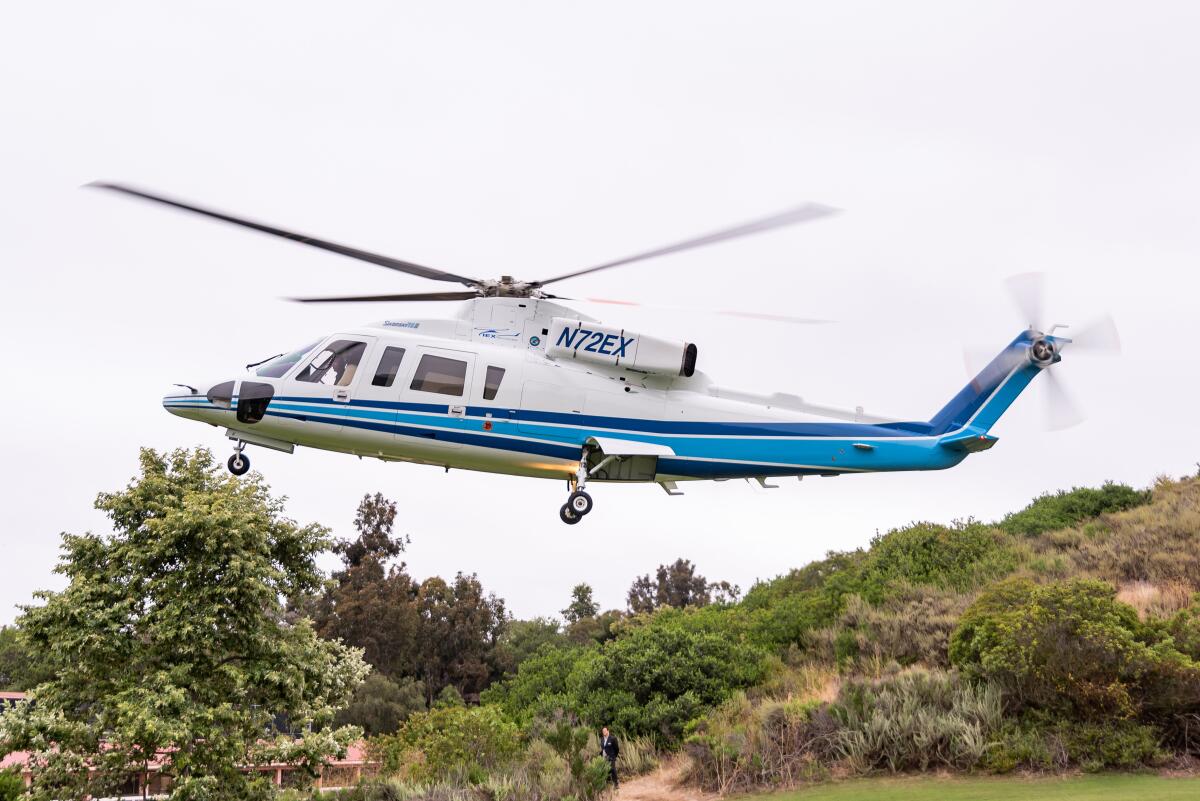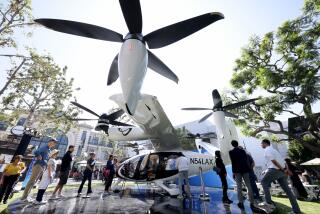Skipping L.A. traffic in a helicopter: ‘Not a poor man’s way of transportation’

- Share via
For Southern Californians with more money than spare time, helicopters have long held appeal.
In this sprawling and traffic-choked region, they shrink commutes and make far-flung destinations accessible in minutes.
It’s a way of travel few have the means to experience — and one now in the spotlight after the crash that killed former Lakers star Kobe Bryant and eight others in Calabasas on Sunday.
The chartered helicopter industry in L.A. isn’t large. Many operators also offer other services, such as filming, tours and aerial photography to maximize use of their expensive vehicles.
But the use of commuter helicopters in the greater Los Angeles area is probably second only to New York City, said Kurt Deetz, who ferried Bryant from 2014 to 2016 as a former pilot for the charter service Island Express Holding Corp.
The customer base skews rich, famous and traffic-averse. In 1997, for instance, Apple Inc. co-founder Steve Jobs got permission from officials in Richmond, Calif., to build a heliport that was only a short drive from his office at Pixar Animation Studios.
“It’s about time and money,” Deetz said. “If you were to go from Orange County to Los Angeles on a Friday at 4 p.m., how long would that take you? It’s convenience.”
Flying in a helicopter from Irvine to downtown L.A. can take just 20 to 25 minutes. A trip to near Staples Center from John Wayne Airport in Santa Ana — a route Bryant took when he played for the Lakers — can take 12 to 14 minutes.
“In an afternoon, it would take probably an hour and a half to drive that same distance,” said Chuck Street, executive director of the Los Angeles Area Helicopter Operators Assn., a trade group comprising several local companies. “And then, of course, you have the wear and tear on the psyche. [Riding in a helicopter instead of driving is] a big stress saver.”
The choppers are used by “everyone from celebrities to actors to investment guys and simply people with a lot of money,” Deetz said. “It’s not a poor man’s way of transportation.”
Taking the type of luxury helicopter Bryant used — a twin-engine Sikorsky S-76B that can seat several people — can cost up to $5,000 an hour, and some operators have a two-hour minimum, Deetz said. Simply buying a seat on a chartered helicopter can cost several hundred dollars, industry executives said.
People use the helicopters for all types of reasons: to attend sporting events at Staples Center and elsewhere downtown, to hold business meetings, to visit real estate developments around Southern California, to enjoy an expensive date or to attend two events in distant parts of the region in a short time frame.
In 2016, Uber offered a helicopter service called UberChopper that flew people from Los Angeles and Orange counties to the Coachella Valley during big music festival weekends for $4,170 each way.
“We would take [Bryant] and the family to Santa Monica all the time” when Bryant wanted to visit the Westside from his home in Orange County, Deetz said.
Executives and celebrities often use private jets for longer-distance travel. But helicopters can be more convenient and cost-effective for a trip within a 100-mile radius.
Downtown Los Angeles has no airport — but it does have a commuter-friendly heliport.
Still, the bulk of commuter helicopter stops in the region are at airports. Beverly Hills, for example, doesn’t allow such helicopter landings, so fliers heading there can land at the airport in Santa Monica and drive the rest of the way, Street said.
For commuters visiting downtown L.A., the primary heliport is atop a parking structure on West Venice Boulevard, a few blocks southeast of Staples Center, Street said.
There are seldom-used helipads in Echo Park and the cities of Commerce and Industry, but overall, “there are very few places where you can land,” which has stymied industry growth, he said.
Street is managing partner at a firm called HeliTrans, which plans to build and operate a network of heliports so helicopters have a place to land and drop off passengers.
Eventually, those landing zones could be used by electric air taxis that take off and land vertically — a vehicle popularly known as a flying car.
A flurry of companies, including Airbus and Boeing, have already developed prototypes of these vehicles, and Uber has hyped plans about an aerial version of its ride-hailing service that would rely on such air taxis. The tech giant has said it would conduct one or two demonstration flights of vehicles as early as this year in either L.A. or Dallas. Commercial flights with passengers could start as soon as 2023, Uber said.
But more air taxis means more pilots, and a recent study predicted that the U.S. helicopter industry would be short about 7,600 helicopter pilots between 2018 and 2036.
The Federal Aviation Administration requires pilots who fly for most charter operators to pass a flight test and exam each year. They must also have a minimum amount of experience: 500 flight hours if they are flying under visual flight rules, which apply when visibility is good and require the helicopter to stay out of clouds, or 1,200 hours for instrument flight rules, which allow the helicopter to operate in clouds.
Companies typically add more requirements for their pilots beyond what the FAA demands, industry executives said.
Some charter pilots are paid by the day rather than a flat salary, and that, combined with their work ethic, means sometimes they feel pressure to fly in inclement weather, said Jon Kettles, an aviation attorney for 29 years who represents people who have lost family members in aviation crashes.
“The go/no-go decision is big,” Kettles said. “I don’t think people realize the pressure that pilots are put under to get the job done.”
Deetz said he had never felt pressure from clients to fly in poor weather. He said that he was salaried at Island Express and that the majority of charter pilots are salaried.
“They’re going to respect your decision if you tell them, ‘I cannot get us there safely,’” he said.
Two years ago, for instance, he was flying a client from Van Nuys to Palm Springs when he encountered heavy low clouds near Banning.
“I told him there’s no way I can get you safely to Palm Springs, that I had ordered an Uber and we’re landing in San Bernardino,” Deetz recalled. “He said, ‘Thank you.’ You have to tell them when the weather isn’t as good as we thought.”
Times staff writer Hugo Martín contributed to this report.
More to Read
Inside the business of entertainment
The Wide Shot brings you news, analysis and insights on everything from streaming wars to production — and what it all means for the future.
You may occasionally receive promotional content from the Los Angeles Times.












